University Economics Assignment: Price, Costs, and Strategies
VerifiedAdded on 2020/03/16
|8
|2637
|80
Homework Assignment
AI Summary
This economics assignment delves into several core microeconomic concepts. It begins with an analysis of price discrimination, examining its impact on consumer and producer surplus, and determining optimal pricing strategies. The assignment then explores the concept of elasticity, calculating the effect of taxation on demand and revenue, and determining the appropriate tax rates based on different elasticity values. Further, the solution analyzes cost structures, marginal cost, and marginal revenue, and their implications on production decisions. The assignment continues with a game theory scenario, assessing firms' strategic choices in advertising, and identifying dominant strategies. Finally, the assignment explores market equilibrium, using the demand-supply model, and concludes with a discussion of asymmetric information in the insurance market, addressing issues of moral hazard and adverse selection, and proposing solutions to mitigate these problems.
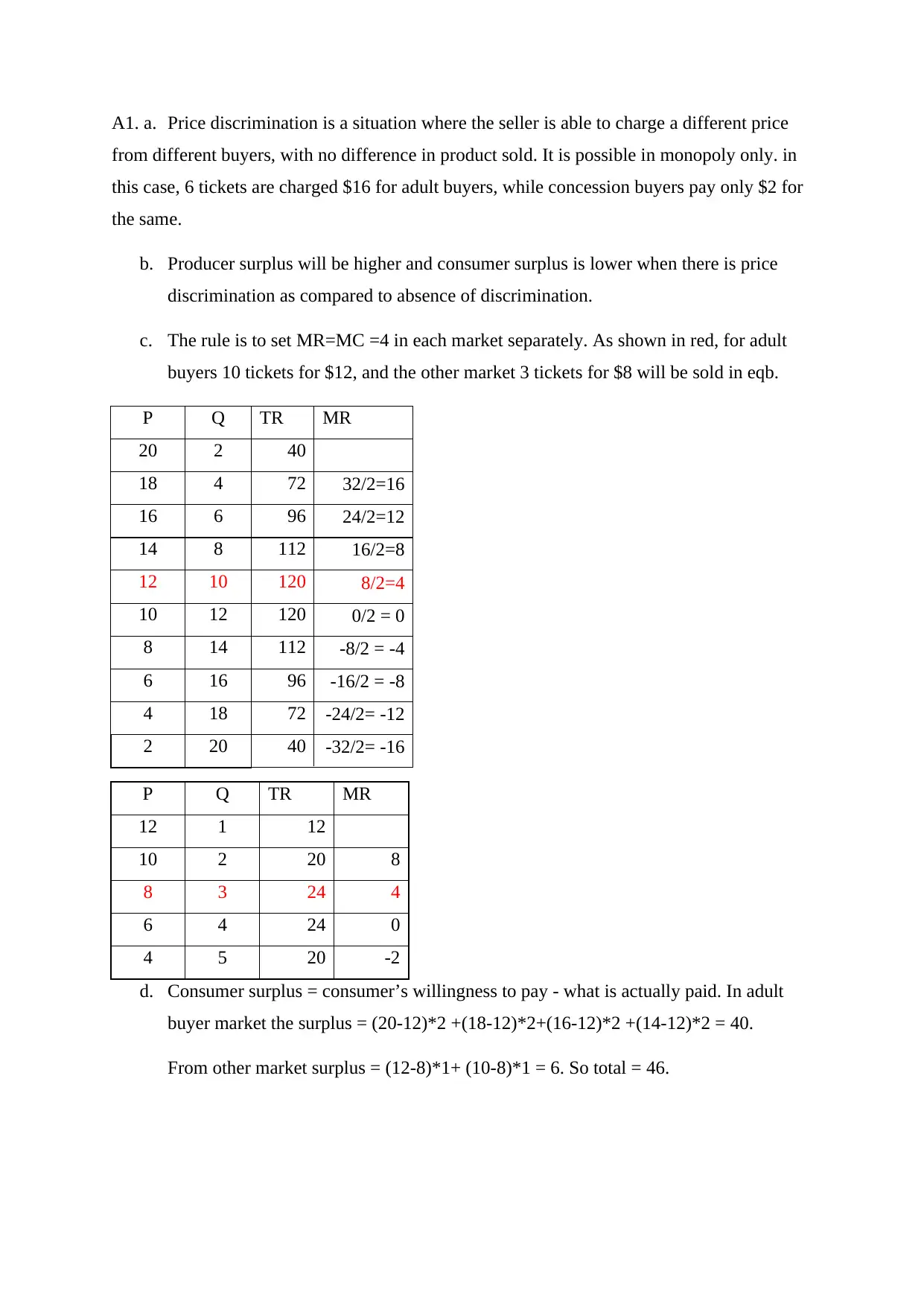
A1. a. Price discrimination is a situation where the seller is able to charge a different price
from different buyers, with no difference in product sold. It is possible in monopoly only. in
this case, 6 tickets are charged $16 for adult buyers, while concession buyers pay only $2 for
the same.
b. Producer surplus will be higher and consumer surplus is lower when there is price
discrimination as compared to absence of discrimination.
c. The rule is to set MR=MC =4 in each market separately. As shown in red, for adult
buyers 10 tickets for $12, and the other market 3 tickets for $8 will be sold in eqb.
P Q TR MR
12 1 12
10 2 20 8
8 3 24 4
6 4 24 0
4 5 20 -2
d. Consumer surplus = consumer’s willingness to pay - what is actually paid. In adult
buyer market the surplus = (20-12)*2 +(18-12)*2+(16-12)*2 +(14-12)*2 = 40.
From other market surplus = (12-8)*1+ (10-8)*1 = 6. So total = 46.
P Q TR MR
20 2 40
18 4 72 32/2=16
16 6 96 24/2=12
14 8 112 16/2=8
12 10 120 8/2=4
10 12 120 0/2 = 0
8 14 112 -8/2 = -4
6 16 96 -16/2 = -8
4 18 72 -24/2= -12
2 20 40 -32/2= -16
from different buyers, with no difference in product sold. It is possible in monopoly only. in
this case, 6 tickets are charged $16 for adult buyers, while concession buyers pay only $2 for
the same.
b. Producer surplus will be higher and consumer surplus is lower when there is price
discrimination as compared to absence of discrimination.
c. The rule is to set MR=MC =4 in each market separately. As shown in red, for adult
buyers 10 tickets for $12, and the other market 3 tickets for $8 will be sold in eqb.
P Q TR MR
12 1 12
10 2 20 8
8 3 24 4
6 4 24 0
4 5 20 -2
d. Consumer surplus = consumer’s willingness to pay - what is actually paid. In adult
buyer market the surplus = (20-12)*2 +(18-12)*2+(16-12)*2 +(14-12)*2 = 40.
From other market surplus = (12-8)*1+ (10-8)*1 = 6. So total = 46.
P Q TR MR
20 2 40
18 4 72 32/2=16
16 6 96 24/2=12
14 8 112 16/2=8
12 10 120 8/2=4
10 12 120 0/2 = 0
8 14 112 -8/2 = -4
6 16 96 -16/2 = -8
4 18 72 -24/2= -12
2 20 40 -32/2= -16
Paraphrase This Document
Need a fresh take? Get an instant paraphrase of this document with our AI Paraphraser
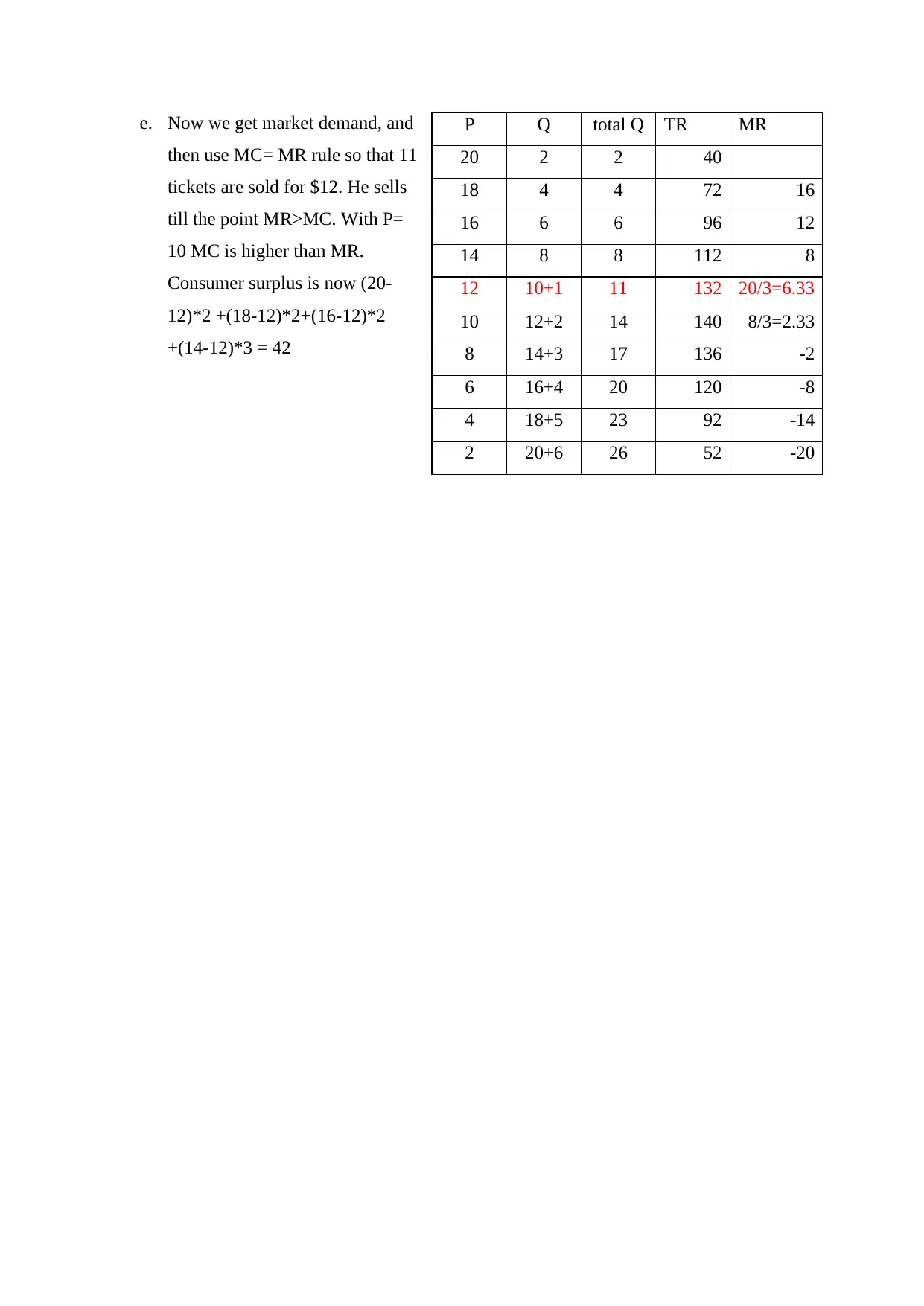
e. Now we get market demand, and
then use MC= MR rule so that 11
tickets are sold for $12. He sells
till the point MR>MC. With P=
10 MC is higher than MR.
Consumer surplus is now (20-
12)*2 +(18-12)*2+(16-12)*2
+(14-12)*3 = 42
P Q total Q TR MR
20 2 2 40
18 4 4 72 16
16 6 6 96 12
14 8 8 112 8
12 10+1 11 132 20/3=6.33
10 12+2 14 140 8/3=2.33
8 14+3 17 136 -2
6 16+4 20 120 -8
4 18+5 23 92 -14
2 20+6 26 52 -20
then use MC= MR rule so that 11
tickets are sold for $12. He sells
till the point MR>MC. With P=
10 MC is higher than MR.
Consumer surplus is now (20-
12)*2 +(18-12)*2+(16-12)*2
+(14-12)*3 = 42
P Q total Q TR MR
20 2 2 40
18 4 4 72 16
16 6 6 96 12
14 8 8 112 8
12 10+1 11 132 20/3=6.33
10 12+2 14 140 8/3=2.33
8 14+3 17 136 -2
6 16+4 20 120 -8
4 18+5 23 92 -14
2 20+6 26 52 -20
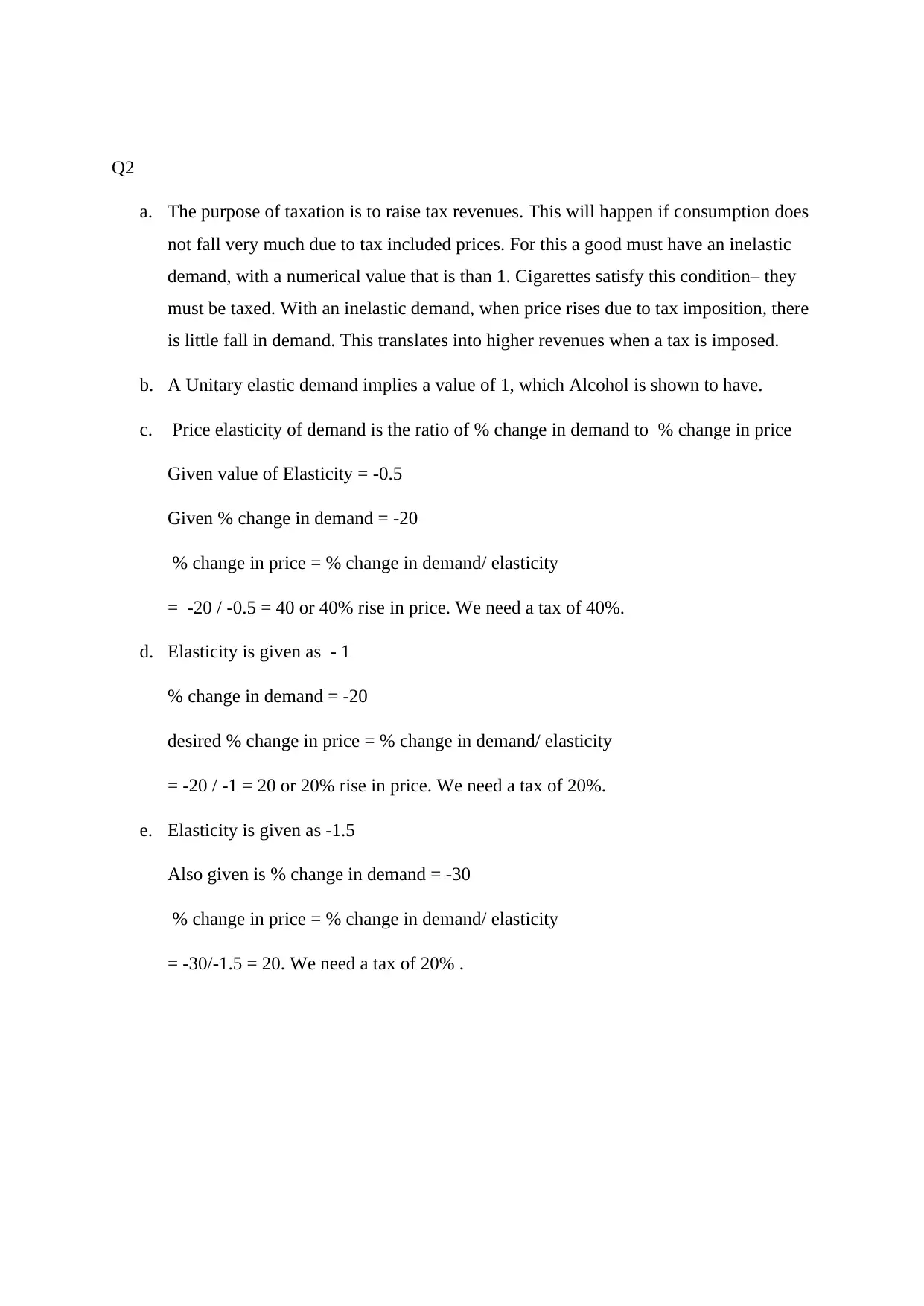
Q2
a. The purpose of taxation is to raise tax revenues. This will happen if consumption does
not fall very much due to tax included prices. For this a good must have an inelastic
demand, with a numerical value that is than 1. Cigarettes satisfy this condition– they
must be taxed. With an inelastic demand, when price rises due to tax imposition, there
is little fall in demand. This translates into higher revenues when a tax is imposed.
b. A Unitary elastic demand implies a value of 1, which Alcohol is shown to have.
c. Price elasticity of demand is the ratio of % change in demand to % change in price
Given value of Elasticity = -0.5
Given % change in demand = -20
% change in price = % change in demand/ elasticity
= -20 / -0.5 = 40 or 40% rise in price. We need a tax of 40%.
d. Elasticity is given as - 1
% change in demand = -20
desired % change in price = % change in demand/ elasticity
= -20 / -1 = 20 or 20% rise in price. We need a tax of 20%.
e. Elasticity is given as -1.5
Also given is % change in demand = -30
% change in price = % change in demand/ elasticity
= -30/-1.5 = 20. We need a tax of 20% .
a. The purpose of taxation is to raise tax revenues. This will happen if consumption does
not fall very much due to tax included prices. For this a good must have an inelastic
demand, with a numerical value that is than 1. Cigarettes satisfy this condition– they
must be taxed. With an inelastic demand, when price rises due to tax imposition, there
is little fall in demand. This translates into higher revenues when a tax is imposed.
b. A Unitary elastic demand implies a value of 1, which Alcohol is shown to have.
c. Price elasticity of demand is the ratio of % change in demand to % change in price
Given value of Elasticity = -0.5
Given % change in demand = -20
% change in price = % change in demand/ elasticity
= -20 / -0.5 = 40 or 40% rise in price. We need a tax of 40%.
d. Elasticity is given as - 1
% change in demand = -20
desired % change in price = % change in demand/ elasticity
= -20 / -1 = 20 or 20% rise in price. We need a tax of 20%.
e. Elasticity is given as -1.5
Also given is % change in demand = -30
% change in price = % change in demand/ elasticity
= -30/-1.5 = 20. We need a tax of 20% .
⊘ This is a preview!⊘
Do you want full access?
Subscribe today to unlock all pages.

Trusted by 1+ million students worldwide
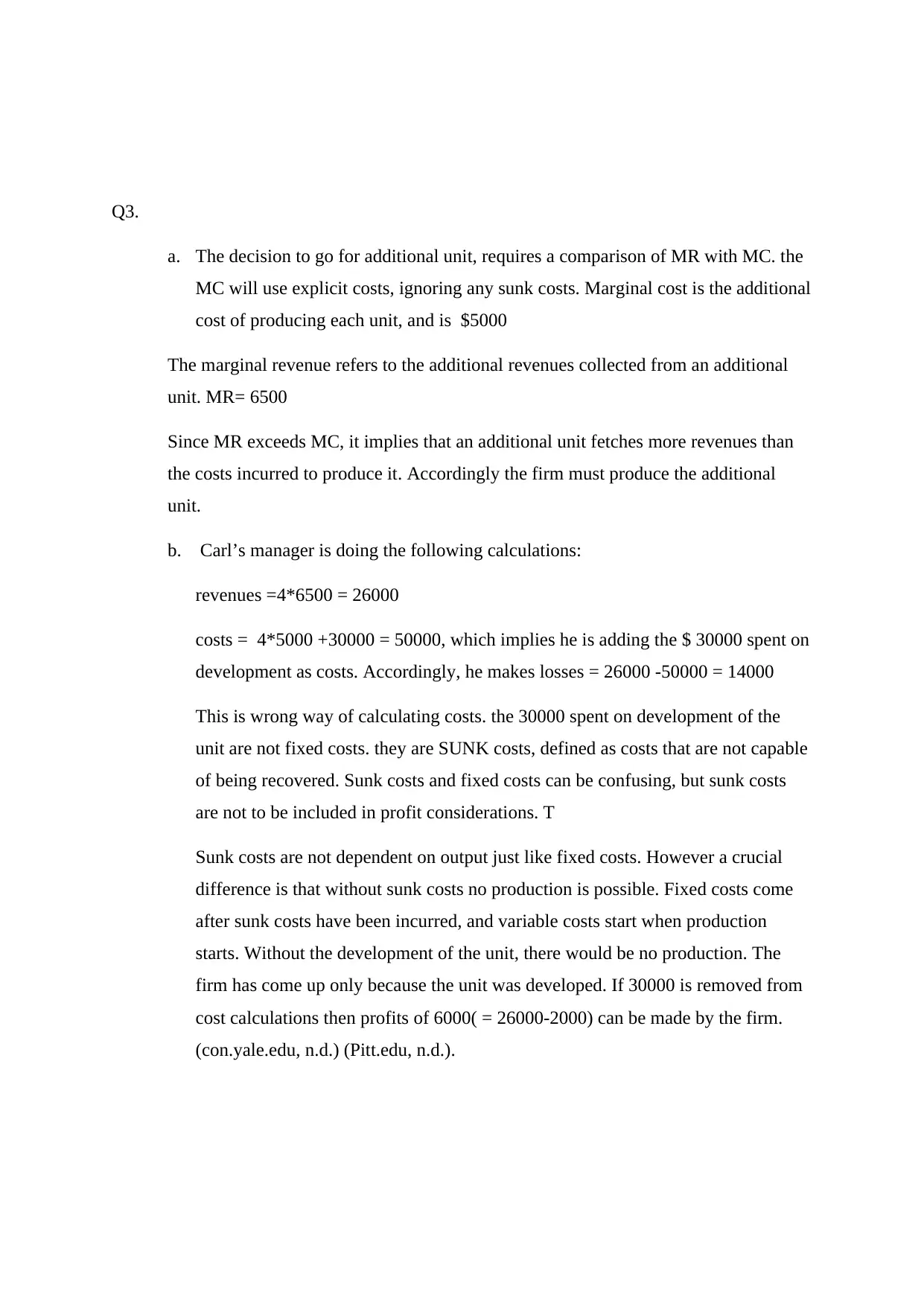
Q3.
a. The decision to go for additional unit, requires a comparison of MR with MC. the
MC will use explicit costs, ignoring any sunk costs. Marginal cost is the additional
cost of producing each unit, and is $5000
The marginal revenue refers to the additional revenues collected from an additional
unit. MR= 6500
Since MR exceeds MC, it implies that an additional unit fetches more revenues than
the costs incurred to produce it. Accordingly the firm must produce the additional
unit.
b. Carl’s manager is doing the following calculations:
revenues =4*6500 = 26000
costs = 4*5000 +30000 = 50000, which implies he is adding the $ 30000 spent on
development as costs. Accordingly, he makes losses = 26000 -50000 = 14000
This is wrong way of calculating costs. the 30000 spent on development of the
unit are not fixed costs. they are SUNK costs, defined as costs that are not capable
of being recovered. Sunk costs and fixed costs can be confusing, but sunk costs
are not to be included in profit considerations. T
Sunk costs are not dependent on output just like fixed costs. However a crucial
difference is that without sunk costs no production is possible. Fixed costs come
after sunk costs have been incurred, and variable costs start when production
starts. Without the development of the unit, there would be no production. The
firm has come up only because the unit was developed. If 30000 is removed from
cost calculations then profits of 6000( = 26000-2000) can be made by the firm.
(con.yale.edu, n.d.) (Pitt.edu, n.d.).
a. The decision to go for additional unit, requires a comparison of MR with MC. the
MC will use explicit costs, ignoring any sunk costs. Marginal cost is the additional
cost of producing each unit, and is $5000
The marginal revenue refers to the additional revenues collected from an additional
unit. MR= 6500
Since MR exceeds MC, it implies that an additional unit fetches more revenues than
the costs incurred to produce it. Accordingly the firm must produce the additional
unit.
b. Carl’s manager is doing the following calculations:
revenues =4*6500 = 26000
costs = 4*5000 +30000 = 50000, which implies he is adding the $ 30000 spent on
development as costs. Accordingly, he makes losses = 26000 -50000 = 14000
This is wrong way of calculating costs. the 30000 spent on development of the
unit are not fixed costs. they are SUNK costs, defined as costs that are not capable
of being recovered. Sunk costs and fixed costs can be confusing, but sunk costs
are not to be included in profit considerations. T
Sunk costs are not dependent on output just like fixed costs. However a crucial
difference is that without sunk costs no production is possible. Fixed costs come
after sunk costs have been incurred, and variable costs start when production
starts. Without the development of the unit, there would be no production. The
firm has come up only because the unit was developed. If 30000 is removed from
cost calculations then profits of 6000( = 26000-2000) can be made by the firm.
(con.yale.edu, n.d.) (Pitt.edu, n.d.).
Paraphrase This Document
Need a fresh take? Get an instant paraphrase of this document with our AI Paraphraser
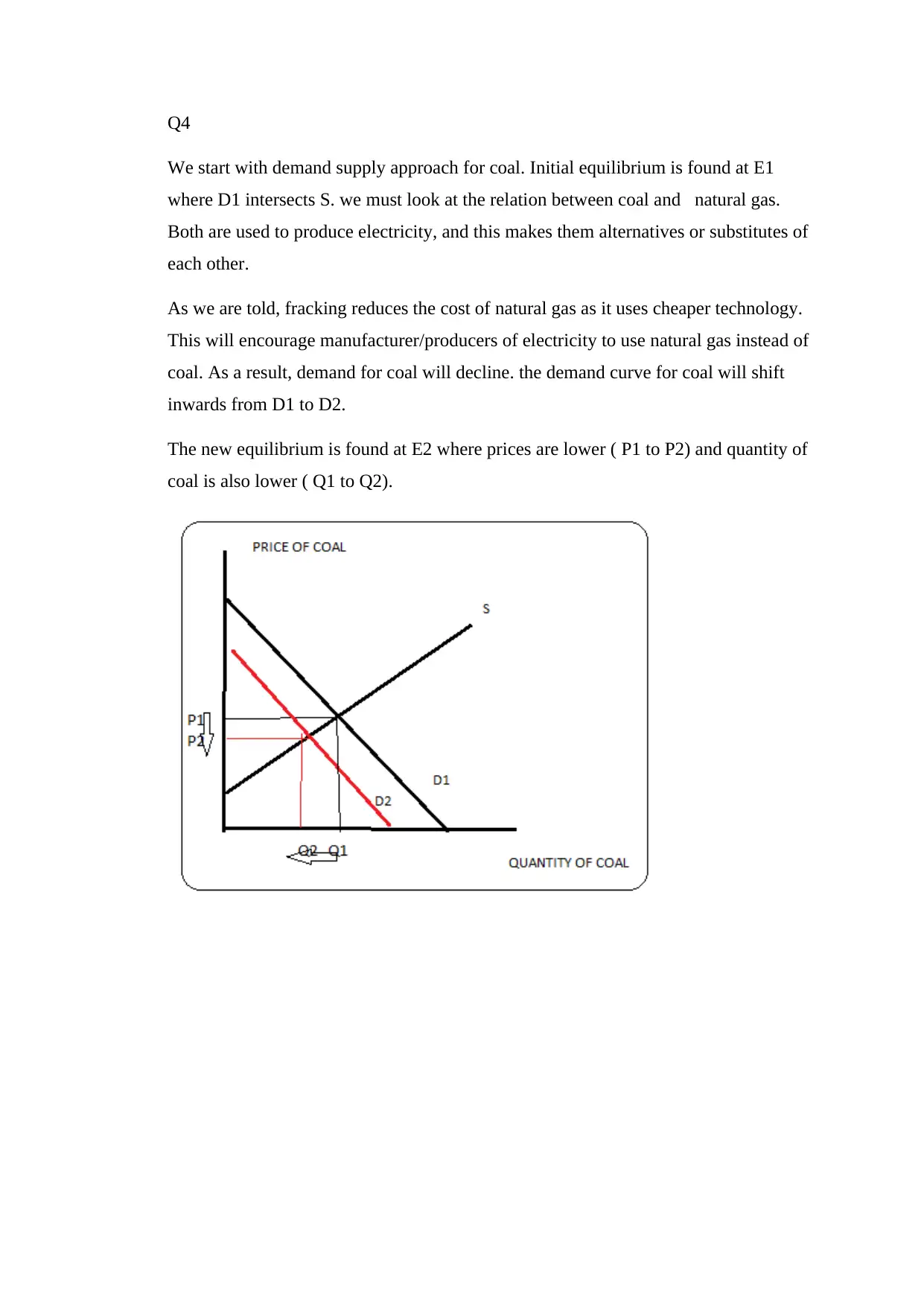
Q4
We start with demand supply approach for coal. Initial equilibrium is found at E1
where D1 intersects S. we must look at the relation between coal and natural gas.
Both are used to produce electricity, and this makes them alternatives or substitutes of
each other.
As we are told, fracking reduces the cost of natural gas as it uses cheaper technology.
This will encourage manufacturer/producers of electricity to use natural gas instead of
coal. As a result, demand for coal will decline. the demand curve for coal will shift
inwards from D1 to D2.
The new equilibrium is found at E2 where prices are lower ( P1 to P2) and quantity of
coal is also lower ( Q1 to Q2).
We start with demand supply approach for coal. Initial equilibrium is found at E1
where D1 intersects S. we must look at the relation between coal and natural gas.
Both are used to produce electricity, and this makes them alternatives or substitutes of
each other.
As we are told, fracking reduces the cost of natural gas as it uses cheaper technology.
This will encourage manufacturer/producers of electricity to use natural gas instead of
coal. As a result, demand for coal will decline. the demand curve for coal will shift
inwards from D1 to D2.
The new equilibrium is found at E2 where prices are lower ( P1 to P2) and quantity of
coal is also lower ( Q1 to Q2).
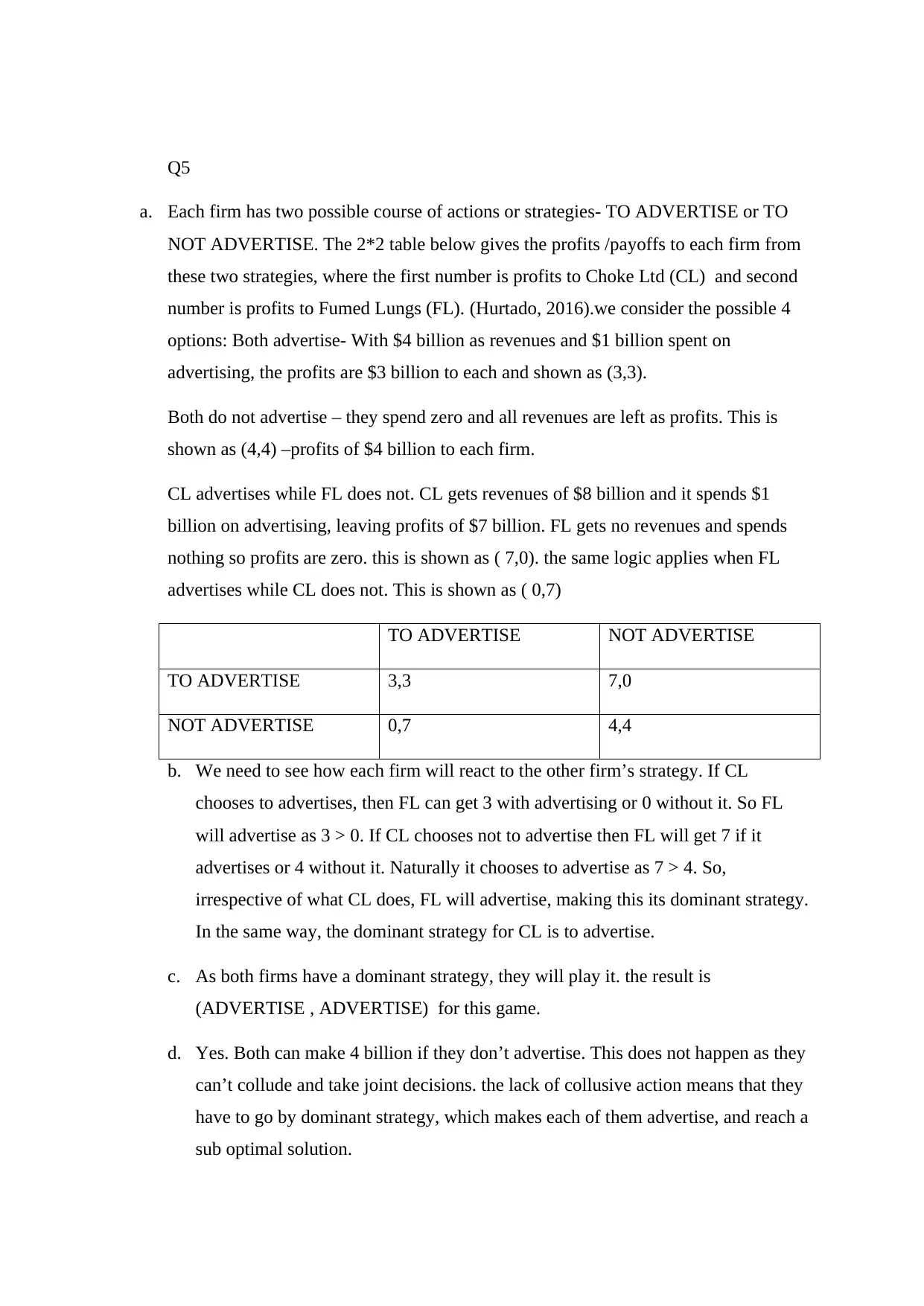
Q5
a. Each firm has two possible course of actions or strategies- TO ADVERTISE or TO
NOT ADVERTISE. The 2*2 table below gives the profits /payoffs to each firm from
these two strategies, where the first number is profits to Choke Ltd (CL) and second
number is profits to Fumed Lungs (FL). (Hurtado, 2016).we consider the possible 4
options: Both advertise- With $4 billion as revenues and $1 billion spent on
advertising, the profits are $3 billion to each and shown as (3,3).
Both do not advertise – they spend zero and all revenues are left as profits. This is
shown as (4,4) –profits of $4 billion to each firm.
CL advertises while FL does not. CL gets revenues of $8 billion and it spends $1
billion on advertising, leaving profits of $7 billion. FL gets no revenues and spends
nothing so profits are zero. this is shown as ( 7,0). the same logic applies when FL
advertises while CL does not. This is shown as ( 0,7)
TO ADVERTISE NOT ADVERTISE
TO ADVERTISE 3,3 7,0
NOT ADVERTISE 0,7 4,4
b. We need to see how each firm will react to the other firm’s strategy. If CL
chooses to advertises, then FL can get 3 with advertising or 0 without it. So FL
will advertise as 3 > 0. If CL chooses not to advertise then FL will get 7 if it
advertises or 4 without it. Naturally it chooses to advertise as 7 > 4. So,
irrespective of what CL does, FL will advertise, making this its dominant strategy.
In the same way, the dominant strategy for CL is to advertise.
c. As both firms have a dominant strategy, they will play it. the result is
(ADVERTISE , ADVERTISE) for this game.
d. Yes. Both can make 4 billion if they don’t advertise. This does not happen as they
can’t collude and take joint decisions. the lack of collusive action means that they
have to go by dominant strategy, which makes each of them advertise, and reach a
sub optimal solution.
a. Each firm has two possible course of actions or strategies- TO ADVERTISE or TO
NOT ADVERTISE. The 2*2 table below gives the profits /payoffs to each firm from
these two strategies, where the first number is profits to Choke Ltd (CL) and second
number is profits to Fumed Lungs (FL). (Hurtado, 2016).we consider the possible 4
options: Both advertise- With $4 billion as revenues and $1 billion spent on
advertising, the profits are $3 billion to each and shown as (3,3).
Both do not advertise – they spend zero and all revenues are left as profits. This is
shown as (4,4) –profits of $4 billion to each firm.
CL advertises while FL does not. CL gets revenues of $8 billion and it spends $1
billion on advertising, leaving profits of $7 billion. FL gets no revenues and spends
nothing so profits are zero. this is shown as ( 7,0). the same logic applies when FL
advertises while CL does not. This is shown as ( 0,7)
TO ADVERTISE NOT ADVERTISE
TO ADVERTISE 3,3 7,0
NOT ADVERTISE 0,7 4,4
b. We need to see how each firm will react to the other firm’s strategy. If CL
chooses to advertises, then FL can get 3 with advertising or 0 without it. So FL
will advertise as 3 > 0. If CL chooses not to advertise then FL will get 7 if it
advertises or 4 without it. Naturally it chooses to advertise as 7 > 4. So,
irrespective of what CL does, FL will advertise, making this its dominant strategy.
In the same way, the dominant strategy for CL is to advertise.
c. As both firms have a dominant strategy, they will play it. the result is
(ADVERTISE , ADVERTISE) for this game.
d. Yes. Both can make 4 billion if they don’t advertise. This does not happen as they
can’t collude and take joint decisions. the lack of collusive action means that they
have to go by dominant strategy, which makes each of them advertise, and reach a
sub optimal solution.
⊘ This is a preview!⊘
Do you want full access?
Subscribe today to unlock all pages.

Trusted by 1+ million students worldwide
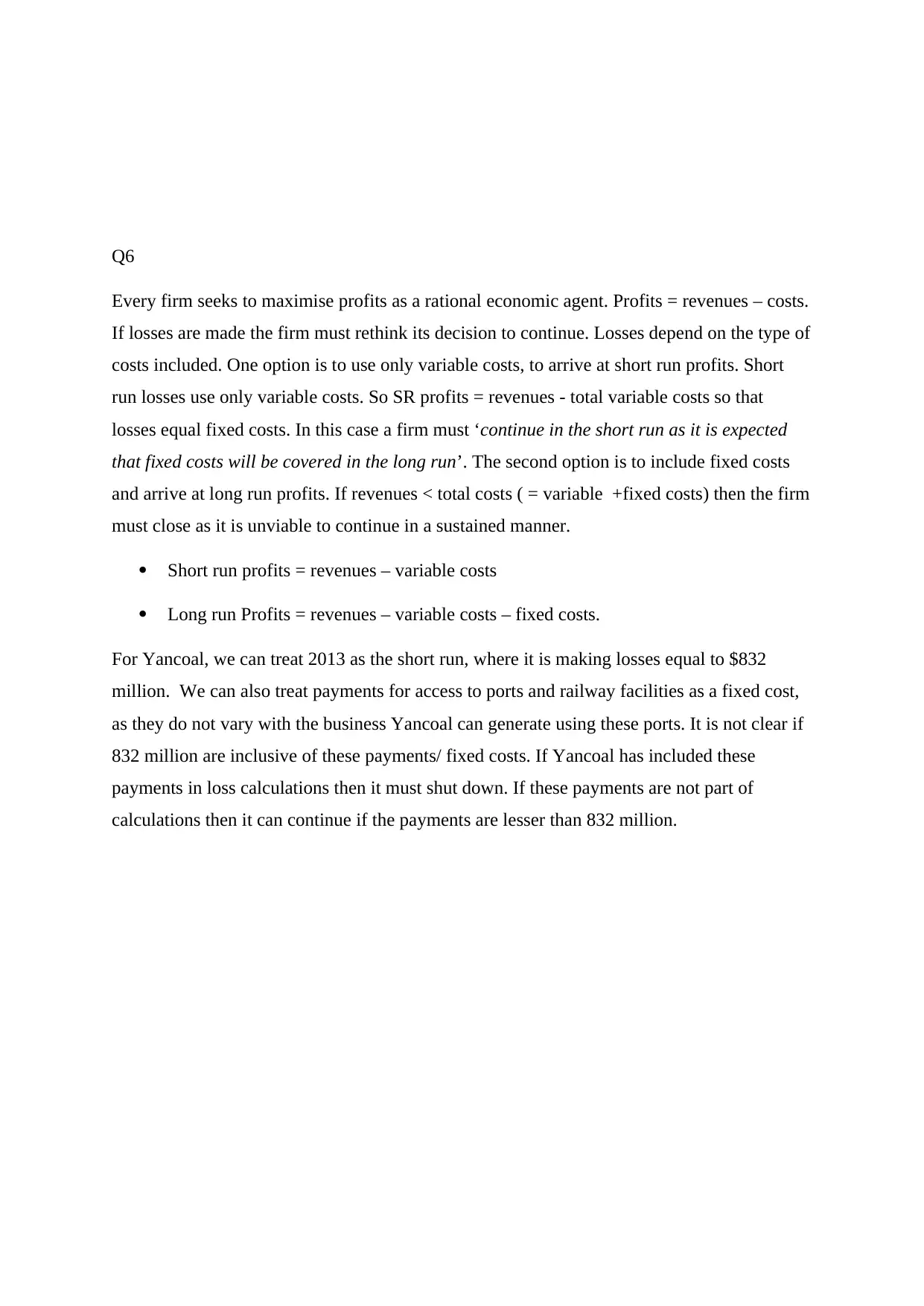
Q6
Every firm seeks to maximise profits as a rational economic agent. Profits = revenues – costs.
If losses are made the firm must rethink its decision to continue. Losses depend on the type of
costs included. One option is to use only variable costs, to arrive at short run profits. Short
run losses use only variable costs. So SR profits = revenues - total variable costs so that
losses equal fixed costs. In this case a firm must ‘continue in the short run as it is expected
that fixed costs will be covered in the long run’. The second option is to include fixed costs
and arrive at long run profits. If revenues < total costs ( = variable +fixed costs) then the firm
must close as it is unviable to continue in a sustained manner.
Short run profits = revenues – variable costs
Long run Profits = revenues – variable costs – fixed costs.
For Yancoal, we can treat 2013 as the short run, where it is making losses equal to $832
million. We can also treat payments for access to ports and railway facilities as a fixed cost,
as they do not vary with the business Yancoal can generate using these ports. It is not clear if
832 million are inclusive of these payments/ fixed costs. If Yancoal has included these
payments in loss calculations then it must shut down. If these payments are not part of
calculations then it can continue if the payments are lesser than 832 million.
Every firm seeks to maximise profits as a rational economic agent. Profits = revenues – costs.
If losses are made the firm must rethink its decision to continue. Losses depend on the type of
costs included. One option is to use only variable costs, to arrive at short run profits. Short
run losses use only variable costs. So SR profits = revenues - total variable costs so that
losses equal fixed costs. In this case a firm must ‘continue in the short run as it is expected
that fixed costs will be covered in the long run’. The second option is to include fixed costs
and arrive at long run profits. If revenues < total costs ( = variable +fixed costs) then the firm
must close as it is unviable to continue in a sustained manner.
Short run profits = revenues – variable costs
Long run Profits = revenues – variable costs – fixed costs.
For Yancoal, we can treat 2013 as the short run, where it is making losses equal to $832
million. We can also treat payments for access to ports and railway facilities as a fixed cost,
as they do not vary with the business Yancoal can generate using these ports. It is not clear if
832 million are inclusive of these payments/ fixed costs. If Yancoal has included these
payments in loss calculations then it must shut down. If these payments are not part of
calculations then it can continue if the payments are lesser than 832 million.
Paraphrase This Document
Need a fresh take? Get an instant paraphrase of this document with our AI Paraphraser

Q7Insurance firms operate in a market which suffers from the problem of asymmetric
information. Such offers are one possible way to reduce the severity of this problem. As the
name suggests, there is unequal information available with the buyer and seller in this market.
The buyer is the customer and seller is the insurance company, while the good sold is an
insurance policy. This asymmetry leads to adverse selection and/or moral hazard issues.
(Fox, n.d.)
We can show these problems with an example. An car insurance policy is sold against
accidents. In an ideal world the premium charged must be higher from a rash driver and
lowers from a safer driver. Safety is not directly observable except using past records, assume
that the records show safe driving records, and an ideal policy with low premiums is issued.
Now for personal reasons the insured person becomes negligent due to recent drinking related
problems. He becomes more risky and there is a greater chance of an accident and seller will
have to compensate and fulfil the claims made in the event of an actual accident. The seller
suffers losses as he has estimated lower chance of paying a claim. The change in safety levels
of driver is a problem of moral hazard as the asymmetry in information about safety levels
has come up after sale of the policy. One way out is to install cameras in the car so that the
seller can monitor behaviour and driving. Periodic checks through driving tests and random
checks on policyholder can also help the insurance firm to update their own information set
about safety parameters. (Borooah.com, n.d.)
Another option is to base of premiums on travelling distance. If the insurance company takes
premiums ( or the price of the policy) on the basis of distance travelled by the buyer, then it
can easily monitor distance through remote of every driver car that it sells to. The aim is to
discourage the driver from travelling beyond the stated distances when he bought the policy.
This way moral hazard can be discouraged from creeping in.
Adverse selection happens as the insurance firm sets an average price for a policy, uniformly
for all buyers. Now the safe drivers will not buy as they are willing to pay a lower premium
in line with their better driving profile. Only the risky drivers will buy the policy as they are
willing to pay the premium which is low based on their risk profile. As a result, the market
only caters to the risky ones, making it tough to sustain for the insurance firm. This is why
most policies are sold at non uniform prices with methods built in to reduce the extent of
asymmetric information.
information. Such offers are one possible way to reduce the severity of this problem. As the
name suggests, there is unequal information available with the buyer and seller in this market.
The buyer is the customer and seller is the insurance company, while the good sold is an
insurance policy. This asymmetry leads to adverse selection and/or moral hazard issues.
(Fox, n.d.)
We can show these problems with an example. An car insurance policy is sold against
accidents. In an ideal world the premium charged must be higher from a rash driver and
lowers from a safer driver. Safety is not directly observable except using past records, assume
that the records show safe driving records, and an ideal policy with low premiums is issued.
Now for personal reasons the insured person becomes negligent due to recent drinking related
problems. He becomes more risky and there is a greater chance of an accident and seller will
have to compensate and fulfil the claims made in the event of an actual accident. The seller
suffers losses as he has estimated lower chance of paying a claim. The change in safety levels
of driver is a problem of moral hazard as the asymmetry in information about safety levels
has come up after sale of the policy. One way out is to install cameras in the car so that the
seller can monitor behaviour and driving. Periodic checks through driving tests and random
checks on policyholder can also help the insurance firm to update their own information set
about safety parameters. (Borooah.com, n.d.)
Another option is to base of premiums on travelling distance. If the insurance company takes
premiums ( or the price of the policy) on the basis of distance travelled by the buyer, then it
can easily monitor distance through remote of every driver car that it sells to. The aim is to
discourage the driver from travelling beyond the stated distances when he bought the policy.
This way moral hazard can be discouraged from creeping in.
Adverse selection happens as the insurance firm sets an average price for a policy, uniformly
for all buyers. Now the safe drivers will not buy as they are willing to pay a lower premium
in line with their better driving profile. Only the risky drivers will buy the policy as they are
willing to pay the premium which is low based on their risk profile. As a result, the market
only caters to the risky ones, making it tough to sustain for the insurance firm. This is why
most policies are sold at non uniform prices with methods built in to reduce the extent of
asymmetric information.
1 out of 8
Related Documents
Your All-in-One AI-Powered Toolkit for Academic Success.
+13062052269
info@desklib.com
Available 24*7 on WhatsApp / Email
![[object Object]](/_next/static/media/star-bottom.7253800d.svg)
Unlock your academic potential
Copyright © 2020–2026 A2Z Services. All Rights Reserved. Developed and managed by ZUCOL.





